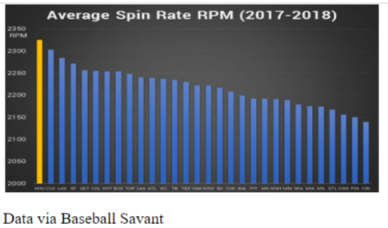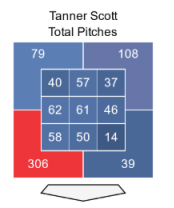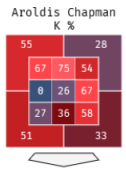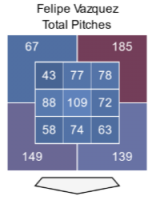By Richard Cosgrove,
The game of Baseball is changing as teams are now using science, numbers, and analytics to develop successful baseball teams. It started out with the 2002 Moneyball Oakland A’s but now has grown all throughout baseball. There seems to be a correlation between success and analytical-turned baseball teams to include Houston Astros, New York Yankees, Los-Angeles Dodgers and the Chicago Cubs just to name a few. Player Development is one of the many things that teams are using analytics to strive in. The Houston Astros have brought Blast Motion into their minor league systems to develop hitters working on bat speed, swing path, time to contact and attack angle. While a variety of other teams have also used technology to develop pitching using Driveline’s ideas of pitch design through Rhapsody and Edgertronic high-speed cameras. Not only have teams, but individual players have also benefited from the use of science to develop pitches to include Trevor Bauer and Adam Ottavino both working out at Driveline during the offseason. Trevor Bauer developed a split-change and Adam Ottavino developed a cutter over this past offseason both improving their ERA and lowering their batting averages against on specific pitches (Bauer 4.19 (17) to 2.21 (18)/Ottavino 5.06 (17) to 2.43 (18)). More and more teams are bringing this into player development as it is helping pitchers become more effective and drawing more strikeouts. One of the many teams falling behind in the modernization of baseball is the Baltimore Orioles. The Baltimore Orioles are coming off a franchise-worst 115 loses and into a full rebuild. The main reason for why they have gotten to this point is due to their lack of developing players especially pitchers. Pitchers to include Kevin Gausman, and Jake Arrieta wasn’t able to reach their full potential in Baltimore but found success with other clubs. They haven’t been willing to keep up with the current trends that these other clubs are using. One of the most modern statistic that teams are looking for pitchers in this age of baseball is Spin Rate and Velocity. Statcast is able to track a pitchers spin rates and teams look for high spin rates in pitchers because they see their potential to develop a potential shutdown pitcher. For example, one of the reasons that Houston signed Charlie Morton was because they saw his potential with such a high spin rate. Not only that, Houston in the past two years has had the highest spin rate in all of baseball (as shown below). 6 out of the 8 top teams on this list were all in the postseason this year while Baltimore is toward the bottom 3rd. Their player development department needs to look into this more to develop pitchers and produce a productive pitching staff.

One example of a pitcher, who I think could benefit from this, is Tanner Scott. In 2018, Tanner finished with a horrendous ERA of 5.40. But he does have an upside with the high spin rate on his slider and fastball. Tanner has a slider with a spin rate of 2663 Revolutions Per Minute (RPM). Not only that, Driveline has a created a measurement to evaluate pitchers called Bauer Units which is Spin Rate (RPM) divided by Velocity (MPH). This helps pitchers better attack hitters based on what part of the zone they should using their pitches. The average Bauer Unit is 24. Anything above average shows that you should pitch middle/up in the zone because the ball doesn’t drop as much coming to the plate. While below average shows that you should be pitching middle/low in the zone. Having an average Bauer Unit of 24, that pitcher should look into developing a two-seam (Boddy). The measurement of Bauer units has not yet been adopted by Major League Baseball, but using this can help build a Pitcher’s repertoire and find their strengths to attacking hitters. First, let’s take a look at Tanner Scott to see how  the Orioles could develop him into a better pitcher. His average fastball has a velocity of 97 mph with a spin rate of 2420 that equates to a Bauer Unit of 24.9. While his slider has an average velocity of 88.7 with a spin rate of 2663 with a Bauer Unit of 30.02. Based on these numbers, his slider has a high spin rate to include an above average Bauer Unit which means lots of movement on the pitch. This is his go-to pitch, his 2018 stats prove this as hitters hit .155 against it with a whiff percentage of 55%. While hitters have a .368 average against his fastball. He needs to compliment that slider and use his pitches better to get more batters out. With an above average Bauer Unit on his fastball at 24.9. He should be throwing his fastball more middle to up in the zone because more spin means more Magnus Force meaning the ball will drop less over the course of the plate (Driveline). Based on Tanner’s pitches last season (left) he threw a lot of his pitches down and into batters. He threw 59.26% of his pitches down in the zone compared to up. Let’s compared this to a guy with a similar fastball Bauer Unit of 25.27 in Aroldis Chapman. Chapman has established himself as one of the top relievers in all of Major League Baseball with fastballs being thrown
the Orioles could develop him into a better pitcher. His average fastball has a velocity of 97 mph with a spin rate of 2420 that equates to a Bauer Unit of 24.9. While his slider has an average velocity of 88.7 with a spin rate of 2663 with a Bauer Unit of 30.02. Based on these numbers, his slider has a high spin rate to include an above average Bauer Unit which means lots of movement on the pitch. This is his go-to pitch, his 2018 stats prove this as hitters hit .155 against it with a whiff percentage of 55%. While hitters have a .368 average against his fastball. He needs to compliment that slider and use his pitches better to get more batters out. With an above average Bauer Unit on his fastball at 24.9. He should be throwing his fastball more middle to up in the zone because more spin means more Magnus Force meaning the ball will drop less over the course of the plate (Driveline). Based on Tanner’s pitches last season (left) he threw a lot of his pitches down and into batters. He threw 59.26% of his pitches down in the zone compared to up. Let’s compared this to a guy with a similar fastball Bauer Unit of 25.27 in Aroldis Chapman. Chapman has established himself as one of the top relievers in all of Major League Baseball with fastballs being thrown at 100 mph plus from the left side very similar to Tanner Scott. While also having a slider that has a similar Bauer Unit of 28.67 to Scott. In 2018, Chapman had a 2.45 ERA that is more than half of Tanners. That saves a team more
at 100 mph plus from the left side very similar to Tanner Scott. While also having a slider that has a similar Bauer Unit of 28.67 to Scott. In 2018, Chapman had a 2.45 ERA that is more than half of Tanners. That saves a team more  than 2.95 runs per game. On the (right), you see Chapman’s total pitches based on zones. He seems to throw more of pitches up in the zone compared to Tanner. With most of his pitches coming up and in. Throwing 45.7% of his pitches down in the zone, that is a 13.56% decrease in pitches down compared to Tanner Scott. Despite both having a similar spin rate to velocity ratio, Chapman is more successful because he is able to use his fastball better to get hitters out which seems to be a weakness for Tanner Scott. This graph (right) also supports the success that Chapman has had to throw up in the zone. By using the top of the zone, he is inducing more swings and misses.
than 2.95 runs per game. On the (right), you see Chapman’s total pitches based on zones. He seems to throw more of pitches up in the zone compared to Tanner. With most of his pitches coming up and in. Throwing 45.7% of his pitches down in the zone, that is a 13.56% decrease in pitches down compared to Tanner Scott. Despite both having a similar spin rate to velocity ratio, Chapman is more successful because he is able to use his fastball better to get hitters out which seems to be a weakness for Tanner Scott. This graph (right) also supports the success that Chapman has had to throw up in the zone. By using the top of the zone, he is inducing more swings and misses.
One of the many teams that have used this logical of using spin rate to their advantage is the Houston Astros. Not only are they the most analytic team, but they are also one the most successful franchises as of late from rookie ball all the way to the big league team. One big example is when they traded for Ryan Pressley, they did so because of his high fastball spin rate. Before he was a reliable reliever for the Minnesota Twins but only seen as just that reliable. With Houston he has been nearly perfect, only gave up 2 earned runs the whole 2nd half of the season. The Astros took him to a whole new level. In his seasons in Minnesota, achieving a career ERA of 3.75. But this season since coming to Houston finished the year with a 0.77 and has since led the Astros to the playoffs in a high leverage role. They took his Bauer Unit of 26.78 which indicates he will have more success throwing it up in the zone. He did just that as seen below (Provided by Petriello).
Fastball rate: 49 percent with Twins, 35 percent with Astros
Curveball rate: 25 percent with Twins, 37 percent with Astros
High fastball rate: 36 percent with Twins, 43 percent with Astros
This example is just one of many, that Houston and other teams have used spin rates of fastballs to their advantage to develop pitchers and take them to the next level. This is something that Baltimore is lacking behind on.
Another weakness that Tanner has is his repertoire of pitches. He basically only has a fastball and slider. In order to get more hitters out, he needs to be able to develop a better array of pitches that get hitters off balance. The more pitches that out of your hand looks like a fastball, the more swings, and misses and even looking third strikes you will get because they don’t know what it is coming until it’s already there. If he is able to develop a pitch that can be thrown down in the zone to include a sinker, splitter, or changeup. He would be golden, he’d have 3 pitches all that out of his hand looks the same but end up somewhere different. That could make a big difference in his success as a major league pitcher and his potential as becoming a possible starter. A prime example of another hard-throwing lefty who is similar to Tanner Scott is Felipe Vazquez. Vazquez has an average fastball of 98 mph (Scott 97 mph) with a Bauer Unit of 26.06 (Scott 24.9). Very similar fastballs while both also throwing sliders with Bauer Units of above 30 (Vazquez 31.67) (Scott 30.02). The big difference between Vazquez’s  success (2.83 career ERA) and Scotts (5.56 career ERA) beside that Vazquez also uses the top of the zone more because of his spin rate(as shown to the right) has to do with the fact that Vazquez has a changeup to go along with these pitches. Scott’s fastball gets hammered by batters at a whopping batting average of .368. Despite having similar fastballs, Vazquez only gets hits at .286, a big drop from Vazquez because he is able to use his other pitches to get outs. Still, .286 is high despite him still having success as a whole, that is because he is able to use his slider and changeup more than his fastball. Adding this pitch to Scotts’ toolbox will allow him to use his fastball less which at times currently gets crushed. Tanner will need to use the high-speed Edgertronic cameras to make sure his changeup is coming out of his hand like a true changeup does and also to make sure his arm slot is the same as his fastball, so it has the same effect that Vazquez’s does.
success (2.83 career ERA) and Scotts (5.56 career ERA) beside that Vazquez also uses the top of the zone more because of his spin rate(as shown to the right) has to do with the fact that Vazquez has a changeup to go along with these pitches. Scott’s fastball gets hammered by batters at a whopping batting average of .368. Despite having similar fastballs, Vazquez only gets hits at .286, a big drop from Vazquez because he is able to use his other pitches to get outs. Still, .286 is high despite him still having success as a whole, that is because he is able to use his slider and changeup more than his fastball. Adding this pitch to Scotts’ toolbox will allow him to use his fastball less which at times currently gets crushed. Tanner will need to use the high-speed Edgertronic cameras to make sure his changeup is coming out of his hand like a true changeup does and also to make sure his arm slot is the same as his fastball, so it has the same effect that Vazquez’s does.
As seen by this video , out of Vazquez’s hand his changeup looks a fastball but then drops. This will cause hitters to be off balance with his pitches. Scott is going to want to play around with his changeup to have a Bauer Unit of about 22ish similar to Vazquez. This will allow him to now have a pitch to throw up (fastball) and down (changeup) in the zone. With his slider as his swing and miss pitch. By doing this with Scott, the Orioles will now have a “Felipe Vazquez” for roughly $3 million less. After working with Tanner Scott to develop this pitch, they need to bring him back in the role that he had in 2017 for the Bowie Baysox. Pitching 3 innings every 5th day, this will allow him to work on his new off-speed pitch and new fastball approach while also working on his mechanics. Tanner is a hard-throwing lefty but he struggles at times throwing strikes. In 2018, he walked a batter every 1.9 innings. That is a high rate, which needs to be brought down. They should send him down to Triple-A Norfolk to work out those kinks and his new approach on the mound. Once he proves he has mastered his new pitches and fastball, promote him to the majors. The 3 innings a start stint worked for Tanner in 2017, as he finished that year with a 2.22 ERA and being selected to the MLB Futures Game. But the next season in 2018, Baltimore sent him back to the bullpen setting him up for that unsuccessful season of an ERA of 5.40. If Baltimore just sends him back into that role with the addition of his fastball location and an addition of one pitch, he will bloom into that prospect he was projected to be in the big leagues. This is just the start of the rebuild of the Baltimore Orioles.
Works Cited
O’CONNELL, MICHAEL. “Bauer Units and Pitch Comparison.” Driveline Baseball, Driveline Baseball, 1 Feb. 2018, www.drivelinebaseball.com/2017/03/bauer-units-pitch-comparison/.
“Statcast.” Major League Baseball, m.mlb.com/statcast/leaderboard.
O’CONNELL, MICHAEL. “Spin Rate: What We Know Now.” Driveline Baseball, Driveline Baseball, 8 Aug. 2018, www.drivelinebaseball.com/2016/11/spin-rate-what-we-know-now/.
“How Astros’ Analytics Improved Their Pitchers.” MLB.com, www.mlb.com/astros/news/how-astros-analytics-improved-their-pitchers/c-297698084.









